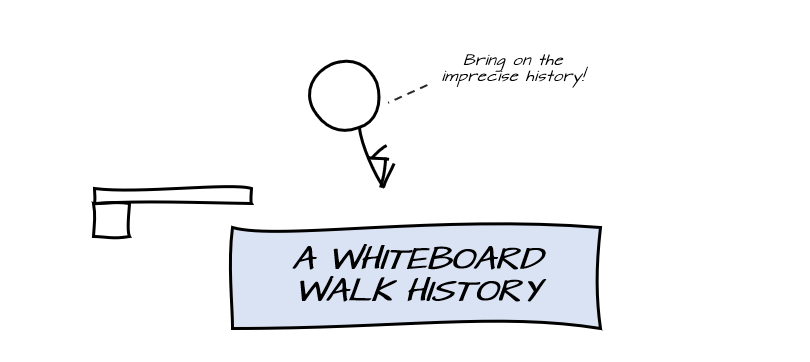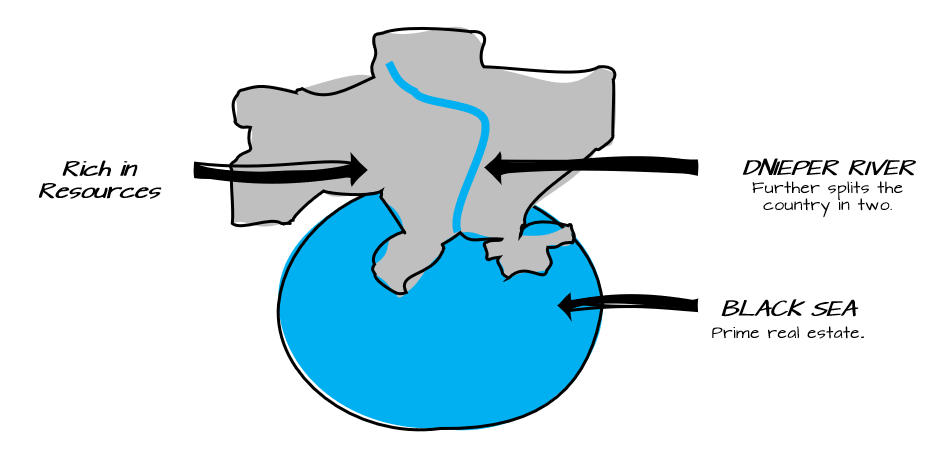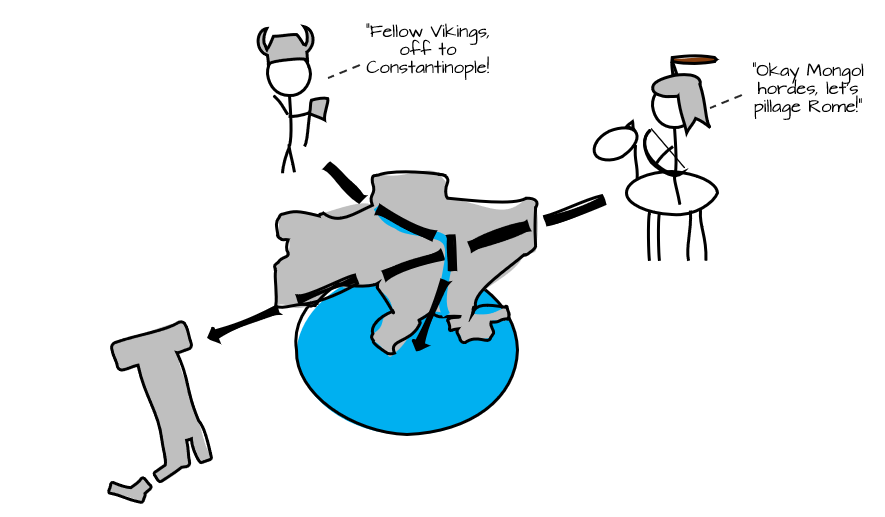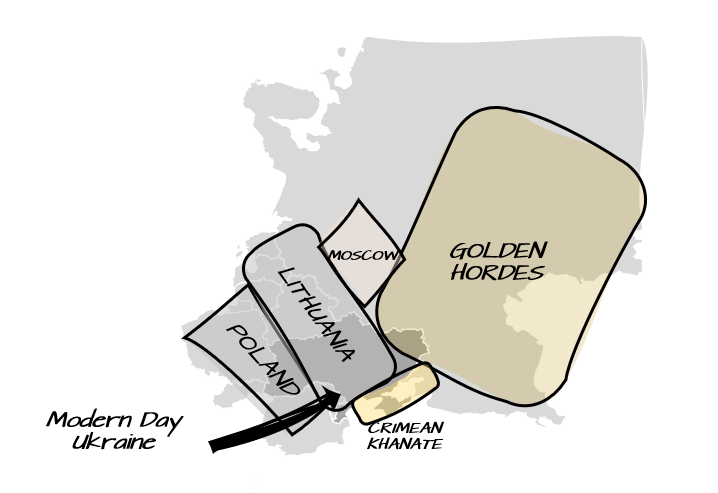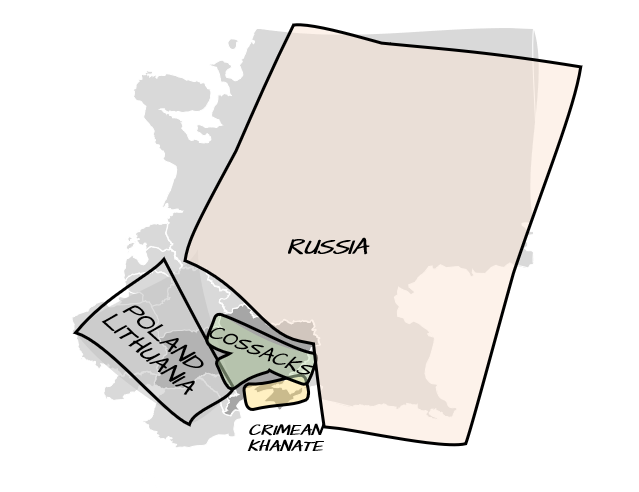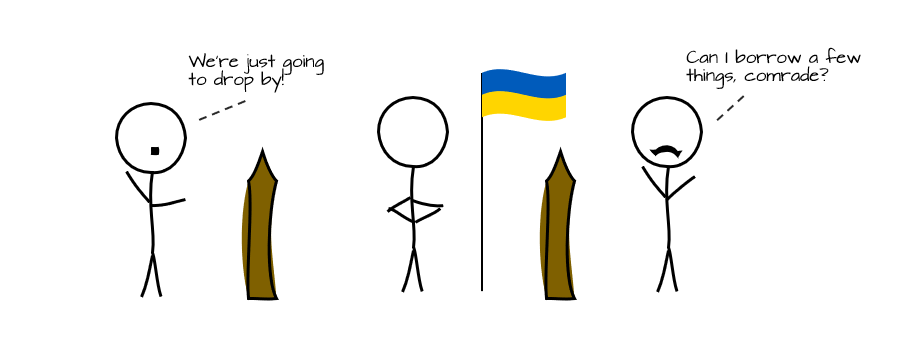So what’s happening in Ukraine? Part 1: How did we get here?
What’s happening in Ukraine right now is complex.
In order to give even a rudimentary explanation - which is exactly what this will be - we must provide a brief overview of the history of Ukraine. As a disclaimer, we are not historians, and the goal isn’t to chronologize Ukraine’s rich history. The goal is to provide just enough information, in an accessible way, to help interpret the situation happening
Let’s dive in.
To tell the story, we’ll focus on a few pivotal points over the last 1500 years of the land’s history, stopping around when Crimea was annexed which will be the focus of the next Whiteboard Walk.
First, a little about Ukraine
To set the stage it’s important to wrap our heads around a few key geographical features of the region of modern Ukraine, as they are relevant to its history and the modern-day situation.
It sits in a philosophical collision zone. In general, that’s a risky place to be.
The Dnieper river runs through it splitting the region in two.
It also has access to some extremely valuable real estate (trading ports) on the Black sea, and is rich in natural resources.
Now that we’ve made Ukraine’s acquaintance, back to the history.
MIDDLE AGES: 476 AD to 1450 AD
During the first few thousand years AD, the land Ukraine is on was historically a very busy place to be.
It was in-and-out of empires, and was an important stop for very scary groups of people on their way to other areas. Being in between Vikings and their destination, or passing by Mongol hordes was not an easy place to call home.
After years of ongoing warring, consolidations and breakups, the region temporarily settled into something that looks like this.
The Polish and Lithuanian states had a fairly close relationship and religious philosophy, while Moscow was off on its own in its political approach. The Hordes were a different beast altogether, but were slowly losing power over the region.
The future Ukrainian territory would be influenced by all of the different powers within the region, however, the Lithuanian influence on the territory was heaviest.
Moscow at this time was isolated, having a different religious and political philosophy from any other territory it bordered with.
EARLY MODERN ERA: 1450 to 1750
As the application of serfdom in the region grew, people fled to the steppes to form their own independent society. These individuals consolidated themselves with the Cossacks. They were a fiercely independent bunch. They were made up people from all different walks of life, and the thing they all had in common was they wanted to be a self-governing group.
In the beginning, they used their organization and military strength to support the Polish commonwealth, but after some disputes they had with the Polish king, they opted to revolt and join sides with Moscow with the objective of claiming their own independent state.
Following the revolt and further fighting, the region looked something like this with the Cossacks carving up their own spot wedged between 3 powers.
It wasn’t long before the Cossacks broke their alliance with the Russians and joined forces with the Swedes in another revolt.
This one didn’t work out so well for them, and they lost that war, effectively losing their newfound independence and finding themselves under Russian rule.
Over the years, Russian rule expanded, pushing out West and controlling all of modern-day Ukraine in the process.
This gave Russia crucial access to the Black Sea – a major trading hub – through Crimea.
Over this time “Russification” took place which is exactly what it sounds like. Russian influence and culture spread heavily across the area, tightening their grip on the territories they controlled.
MODERN ERA: 1750+
Toward the start of the 1800s, Russian rule began to wane.
Revolutions – including the French revolution – challenged the global power balance, and two lost wars proved that Russia wasn’t invincible.
Coinciding with WW1, Ukraine tried to claim independence during the Russian Revolution, but was ultimately unsuccessful.
Over the next 20 years the control of Ukraine would switch hands between warring factions and groups, ultimately settling again with Ukraine being controlled by the USSR.
At this time Ukraine started to industrialize quite heavily, and was very resource-rich territory for the USSR.
Great news for Ukraine right? Well, the one downside of all this growth is it can make your neighbours a little jealous.
This put Ukraine in a very tough place in the early / mid- 1900s, and as a country / people they went through A LOT.
At the time the USSR dissolved in 1991, the vast majority of Ukrainians - including those of Russian descent placed there over the years - voted for independence.
However, the ties with Russia remained much stronger within Ukraine than in many former Soviet territories.
During the split, Ukraine ended up with a portion of the USSRs nuclear arsenal, which it gave back to Russia in exchange for a guarantee of protection, and its sovereignty as a nation.
Modern Day
If you are wondering why Ukraine is still a hotbed for wars of influence and control, you have to look at the world’s geopolitical situation at an aggregate level.
Put aside the individual countries that make-up Europe, and look at alliances at a NATO level.
When you look at it from this vantage point, the wars for control of the past don’t look so different. While a little more nuanced, the power struggles in the region are still very much present.
With this view you can see that Ukraine is actually a very important buffer zone for Russia against the expansion of NATO and its influence.
To add more complexity and nuance to the matter, Ukraine itself isn’t a homogenous group of people.
While the majority of Ukrainians today identify as such, there does exist a sizable minority of ethnic Russian people in parts of Eastern Ukraine and Crimea. These groups are primarily Russian speaking, and many of them identify as Russian and some offer tacit support to the Russian Federation.
This creates a natural tension within the country, as outside influences constantly seek to gain more cultural and political power over the region.
This piece could have filled an entire encyclopedia if done right, but the objective was to give a general overview on the history of Ukraine, in order to set the context for what is happening in present day.
The next piece will focus on the next chapter in its history - the Russian annexation of Crimea.
Think someone in your network can benefit from this brief summary of Ukraine’s history? Share below!

